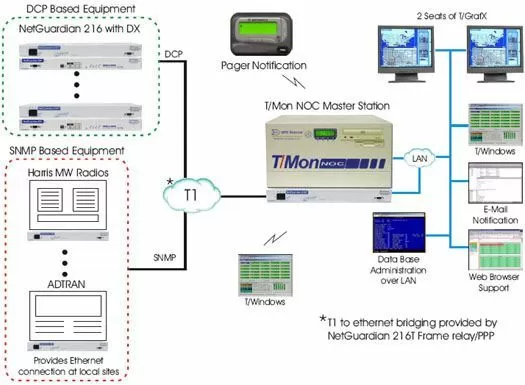Download our free Monitoring Fundamentals Tutorial.
An introduction to Monitoring Fundamentals strictly from the perspective of telecom network alarm management.
1-800-693-0351
Have a specific question? Ask our team of expert engineers and get a specific answer!
Sign up for the next DPS Factory Training!

Whether you're new to our equipment or you've used it for years, DPS factory training is the best way to get more from your monitoring.
Reserve Your Seat TodayThe KDA by DPS Telecom is a durable, reliable RTU. While it has been superseded by the NetGuardian 832A, its design still stands the test of time with a large number of units still active. If you have KDAs deployed in your network but are looking to upgrade from Four-wire to a T1 connection, this tutorial can help. Depending on your budget and size of your network, we offer two options for upgrading your connection, which are discussed later. While this example specifically calls out Harris microwave radios and ADTRAN, it can actually be applied to a variety of legacy gear. If you have questions about your specific network layout and how to apply this application, feel free to call DPS Tech Support.

Moving away from a Four-Wire connection into a T1 connection is something that DPS Telecom can help with. It is especially key that you have decided to make the KDA864 part of that plan. This is a testament to the durability of the KDAs.
DPS has consistently improved both upon their platforms and the technology inside each unit. While the KDAs are still fully supported, the next generation of NetGuardians have been released, featuring a T1 interface.
Therefore, here are two separate upgrade options:
Option 1: Retrofitting Your KDAs.
The First Option features retrofitting your KDAs. The KDA shelfs will be refurbished and shipped back supporting new NIA cards. You will need to provide the T1 to LAN bridging equipment for their operation. This option saves you money as you don't have to purchase new RTUs. The downside however is that you have to provide additionally equipment to bridge the T1 to LAN. Plus, this option may work for a while but you have to keep in mind how to maintain it. What if you can no longer get the equipment? What if the only person that knows how the system works leaves or retires? As mentioned before, the KDAs are still fully supported, but the same can not be said for other manufacturers.

Option 2: Upgrading to the new NetGuardian 216T.
The Second Option provides a significant advantage to your long term goals. It involves retiring your existing KDAs and replacing them with the new NetGuardian 216T. The NetGuardian 216T, coupled with the NetGuardian DX, will provide alarm monitoring of 64 Discrete Points, 7 Analogs and 10 Controls. This will not only exceed your requirements, but can allow an additional two NetGuardian Discrete Expansion modules to be added in the future (for a total of 160 Discrete Points). This gives you enough capacity for today, while still leaving room to grow in the future. Plus, this option requires no additional bridge equipment. The unit can do both T1 and LAN, so if in the future you decide to only use LAN, your equipment is already set up to handle it.

Other benefits of the NetGuardian 216T include:
While refurbishing your old equipment may sound like it will save you money, it actually doesn't. The NEtGuardian 216T gives you the capacity you need with room for your network to grow. Plus, by replacing your existing KDAs with the new NetGuardian 216T, you're saving yourself from headaches later. Eliminate the solution stack hack and reduce your risk of something going wrong later. Replace your KDAs with the new NetGuardian 216T RTU to monitor your Harris microwave radios and your ADTRAN.